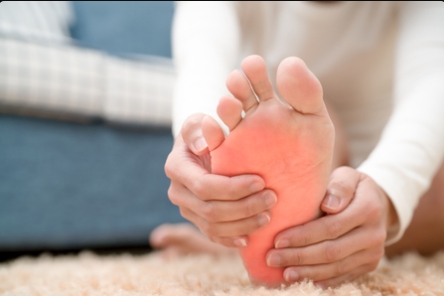
Plantar fasciitis, a common cause of heel pain, affects millions of people worldwide, but women are at a notably higher risk than men. This disparity arises from a combination of biological, structural, and lifestyle factors. There is also evidence supporting the role that hormonal changes can play in developing plantar fasciitis. Let’s dive into why women are more prone to plantar fasciitis and how life stages like pregnancy and menopause play a role.
Hormonal Influences on the Plantar Fascia
Hormones can significantly impact the connective tissues in the body, including the plantar fascia. We know that estrogen and progesterone levels change not only throughout the menstruation cycle, but also at different phases of life. Other hormones such as testosterone also directly impact connective tissue and other structures.
Don’t worry, I will not bore you with a detailed lesson on the endocrine system. However, I will stress that during pregnancy and menopause, hormonal levels drastically change and impact all of the systems of women’s bodies. This includes the musculoskeletal system as well. Structures such as bones, muscles, tendons, and ligaments are responsive to what the endocrine, or the hormonal system, is doing.
Let’s talk about pregnancy and plantar fasciitis first…
Pregnancy introduces several risk factors that can lead to or exacerbate plantar fasciitis:
- Weight Gain: The additional weight gained during pregnancy increases pressure on the feet, particularly the arches and heels. We expect for women who are not overweight prior to pregnancy to gain additional weight during pregnancy, and this weight gain can increase the risk of plantar fasciitis. This region of the foot is made to help absorb shock. If there is more weight present, then the forces absorbed in this area are automatically higher.
- Shifts in Posture: As the belly grows, the center of gravity shifts, often altering gait and placing added stress on the plantar fascia. It has been shown that more pressure is placed on the forefoot and that this can increase the risk of plantar fasciitis.
- Fluid Retention: Swelling in the feet can exacerbate discomfort and strain in the plantar fascia for several reasons. Fluid retention can impact gait and cause for some areas to have to absorb more forces, and increase the risk of pain. This additional fluid can also impact the muscles ability to perform their job of assisting with support, thereby placing additional force on the plantar fascia. (I feel that it is important to mention here that fluid retention can be a normal pregnancy related side effect; however, it is important to relay this information to your provider as it can also be a sign of something more serious.)
- Changes in Foot Structure: Ladies, if you notice that your foot size increased in response to pregnancy, it isn’t in your head. This is actually pretty common for women to experience. For some women, it can lead to lasting changes, increasing the risk of plantar fasciitis both during and after pregnancy. With the increased weight and hormonal changes, some women will notice that their arches begin to decrease and their feet become flatter.
Can menopause really impact my feet?
The short answer is, yes. Menopause is a systemic change meaning that it can impact your entire body. But, the truth is that these changes can begin even before menopause occurs.
Menopause is the absence of a menstrual bleed for at least 12 months, but this is not an abrupt change that occurs. There is a bridge process called perimenopause where these hormonal changes start. And, perimenopause generally occurs between the ages of 35-45 with menopause occurring on average in the early 50s.
**Special Note: Menopause can be medically induced through medications and/or surgery. If this occurs, the body undergoes these changes abruptly.
Menopause brings a host of hormonal and physical changes that can make women more prone to plantar fasciitis. Here are a few of the changes that can occur:
- Decline in Estrogen: Lower estrogen levels during menopause can reduce tissue elasticity, making the plantar fascia more prone to stiffness and injury.
- Bone Density Loss: Changes in bone density can alter foot mechanics and increase stress on the plantar fascia. And, estrogen is responsible for decreased bone density. This is a good time for me to stress that these changes can begin in your 30s if you are not proactive with exercise, including strength training.
- Weight Gain: Hormonal changes during menopause often lead to weight gain, which adds pressure to the feet. Weight gain related to menopause tends to present with more fat deposits in the abdominal region. This can have a direct impact on posture, and in return impact foot positioning during gait.
- Weakened Muscles: Age-related muscle loss can reduce the foot’s ability to support itself, further straining the plantar fascia. What is responsible for decreased muscle mass? Yep, estrogen is the main culprit. And, this is when I will once again mention the importance of lifelong exercise in maintaining healthy muscles because these changes start as well in our 30s.
What can you do about plantar fasciitis?
As a physical therapist and a runner, this is a diagnosis that I am very :familiar and have helped many manage and eliminate symptoms. So, here are a few tricks that I go over with my own patients that they can implement immediately.
- Stretches: Stretching the plantar fascia and calf muscles can be very helpful. But, don’t stop there. Make sure you stretch hamstrings, quads, and piriformis muscles as well!
- Strengthening: Improving the strength of your foot and ankle can be very helpful, but is not the final answer. Your foot and ankle rely on your hips and core, so do not forget to strengthen those muscles as well.
- Massage: Who does not like a good foot massage? This is something that you can do on your own to control the amount of pressure. You can either use a massage ball, tennis ball, rolling pin, or frozen water bottle and roll it under your feet. Here are some links for options on massage tools.
- Cold application: If this is a new onset of pain and inflammation is present, ice can be helpful for some people. If you use a frozen water bottle, you can do both the massage and cold treatment at the same time. If you do not want to freeze a water bottle, here are some cold massage tool options that you can look at.
- Shoe wear: Ladies, I like a good pair of high heels, but they are not the best if plantar fasciitis is the issue. Also, for those who wear the same shoes everyday, simply alternating your shoe wear can be helpful. Look for shoes that offer your support of cushion based on how your foot feels in the shoe. I know you’ll hear shoes for pronators (flat feet) and shoes for supinators (higher arch), but the truth is that you want to find a shoe that feels good t you. So, my rule of thumb is if the shoe does not feel comfortable when you put it on, then don’t wear it.
Final Thoughts
Ladies, we might be at higher risk for plantar fasciitis, but that does not mean that we have to suffer with this pain. I mentioned before that I am a runner and have dealt with plantar fasciitis before. Thankfully, by performing strengthening, massage techniques, and being mindful of my shoewear, I have not had any issues in a LONG time. And, to be honest, I still occasionally wear heels. The most important takeaway is knowing that we are at higher risk, but we can also work towards having pain free feet.
*As an Amazon Associate, I am eligible to earn commission from qualifying purchases.
